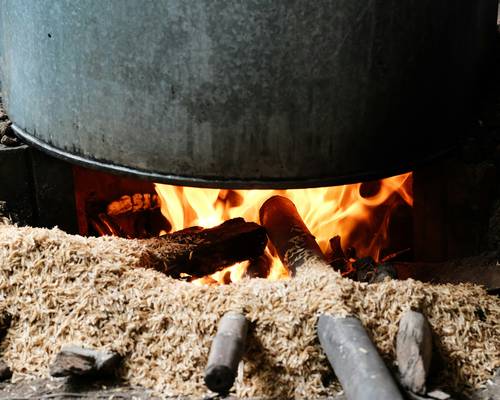Overview: The Main Types of Stove Fuels
- Firewood (Logs): The classic renewable fuel for wood stoves. Requires sourcing, cutting, splitting, and drying.
- Wood Pellets: Compressed sawdust or biomass pellets, used in automated pellet stoves.
- Natural Gas/Propane: Clean-burning fossil fuel, delivered via pipelines or on-site tanks.
- Coal: Dense, long-burning fuel (primarily anthracite) for powerful heat output.
- Electricity: Powers resistance heating elements in modern electric stoves—no combustion or on-site emissions.
Each fuel type has its own pros, cons, costs, and storage needs. Read on for a detailed breakdown!
Stove Fuel Types Compared
| Fuel | Typical Cost | Efficiency | Storage Needs | Best For | Environmental Impact |
|---|---|---|---|---|---|
| Firewood (Logs) | Low (if self-supplied); Moderate to High (purchased) | 60–80% (EPA stoves) | Needs dry, covered storage (6–12 months seasoning) | Rural/off-grid, renewable heating, ambiance | Carbon-neutral if sourced sustainably; some particulate emissions |
| Wood Pellets | Moderate | 70–85% | Clean, dry indoor area; bagged (40-lb typical) | Automated heating, eco-friendly homes | Renewable, low emissions, low ash |
| Natural Gas/Propane | Low to Moderate (varies by market) | 70–90% | Gas line (NG) or tank (propane) | Urban/suburban, convenience, fast heat | Lower emissions than wood/coal; fossil fuel |
| Coal (Anthracite) | Low to Moderate (in coal regions) | 60–80% | Dry, vented, bulk or bagged storage | Cold climates, long burns, rural/off-grid | Higher CO2, particulates; less renewable |
| Electricity | Moderate to High (varies by rate) | ~100% (at point of use) | No storage; grid connection | Zone/supplemental, rentals, apartments | Zero on-site emissions; depends on grid mix |
Note: Costs and efficiency vary by region, appliance, and usage. Always check local rates and supply before choosing a fuel.

Wood vs. Pellet vs. Gas vs. Coal vs. Electric: Quick Pros & Cons
- Firewood: Cheapest if self-supplied; labor-intensive; off-grid; cozy ambiance; requires storage and seasoning.
- Pellets: Consistent, automated, eco-friendly; requires electricity; higher upfront cost; easy to store and handle.
- Gas: Clean, instant heat, low maintenance; needs utility hookup or tank; not off-grid unless using propane.
- Coal: Longest burns, lots of heat; more ash and maintenance; limited regional supply; not eco-friendly.
- Electric: Simplest install, safe, portable; costs depend on power rates; no heat during outages.
Fuel Cost Comparison (Approximate, By BTU)
| Fuel | Cost per Million BTU* | Notes |
|---|---|---|
| Firewood | $8–$25 | Varies by local supply, species, and self-cutting vs. delivered |
| Wood Pellets | $15–$30 | Bagged pellets, prices fluctuate by region/season |
| Natural Gas | $8–$20 | Depends on market rates; often cheapest where available |
| Propane | $18–$40 | Higher in rural areas or winter months |
| Coal (Anthracite) | $12–$25 | Cheapest in coal-producing regions; price volatile elsewhere |
| Electricity | $25–$60 | Varies by local kWh rate; best for small/zone heating |
*Estimates only. Actual costs vary by region, supply, and efficiency. Always compare based on your local rates.
Storage & Handling: What to Know About Each Fuel
Firewood
- Needs covered, elevated storage to season and stay dry
- Stack wood for airflow; allow 6–12 months to dry
- Requires space and regular handling
Wood Pellets
- Bagged (40-lb typical); store indoors or in dry, rodent-free area
- Easy to pour, minimal mess
Gas (Natural/Propane)
- Natural gas: utility line—no on-site storage
- Propane: outdoor tank; periodic refills needed
- Professional installation and leak checks required
Coal
- Bulk or bagged; must stay dry to ignite easily
- Store outdoors in a shed or bin; use a coal scuttle for daily loads
- Produces more ash than wood or pellets
Electricity
- No on-site storage—uses grid power
- Portable, simple; outage = no heat
Environmental Impact: Which Stove Fuel Is Greenest?
- Firewood: Carbon-neutral if sourced and burned sustainably; produces particulates but can be minimized with EPA stoves and dry wood.
- Pellets: Made from waste wood/biomass; low particulates; sustainable and very eco-friendly if local supply used.
- Gas (Natural/Propane): Lower CO2 and particulates than wood/coal; still a fossil fuel (not renewable).
- Coal: Highest CO2 and pollution; not renewable; best for regions where other fuels are impractical.
- Electricity: Zero on-site emissions; green only if grid is renewable (solar, wind, hydro, etc.).
Choosing the Best Stove Fuel for Your Home
- Availability: What’s cheapest and easiest to obtain in your area?
- Convenience: Do you want automated heat (pellet/gas/electric) or don’t mind daily fueling (wood/coal)?
- Storage: Do you have space for a woodpile, pellet bags, or coal bin?
- Budget: Consider both upfront costs and ongoing fuel expenses.
- Environmental Priorities: Want the greenest option? Pellets, sustainably sourced wood, or electric (on green grid) are best.
- Backup Power: Off-grid or power outage reliability: wood and hand-fired coal stoves win.
Stove Fuel Types: Frequently Asked Questions
- What’s the cheapest stove fuel? Firewood is usually cheapest (especially if self-supplied), followed by natural gas, then pellets, coal, propane, and electricity.
- Is burning wood or pellets bad for air quality? Modern EPA stoves and dry fuel minimize smoke; pellets are especially clean. Avoid old, non-certified wood stoves.
- Can I use multiple fuels in one stove? Only in stoves designed as “multi-fuel.” Never burn a fuel type not rated for your stove.
- Does electric heat cost more? Usually, yes—for whole-house heating. It excels for small rooms and supplemental heat due to simplicity.
- How do I store fuel safely? Keep wood and pellets dry and off the ground; coal in a bin or shed; propane tanks outside; gas lines inspected; electricity—no storage needed.
Related Guides
Types of Heating Stoves
Explore how different stoves use different fuels—find the perfect match for your home and lifestyle.
Compare Stove TypesEco-Friendly Stove Options
Learn which fuels and stoves have the lowest carbon footprint and cleanest burn.
Eco-Friendly OptionsEnergy Efficiency for Heating Stoves
Maximize heat and minimize fuel costs—see which fuels and technologies are most efficient.
Efficiency Guide